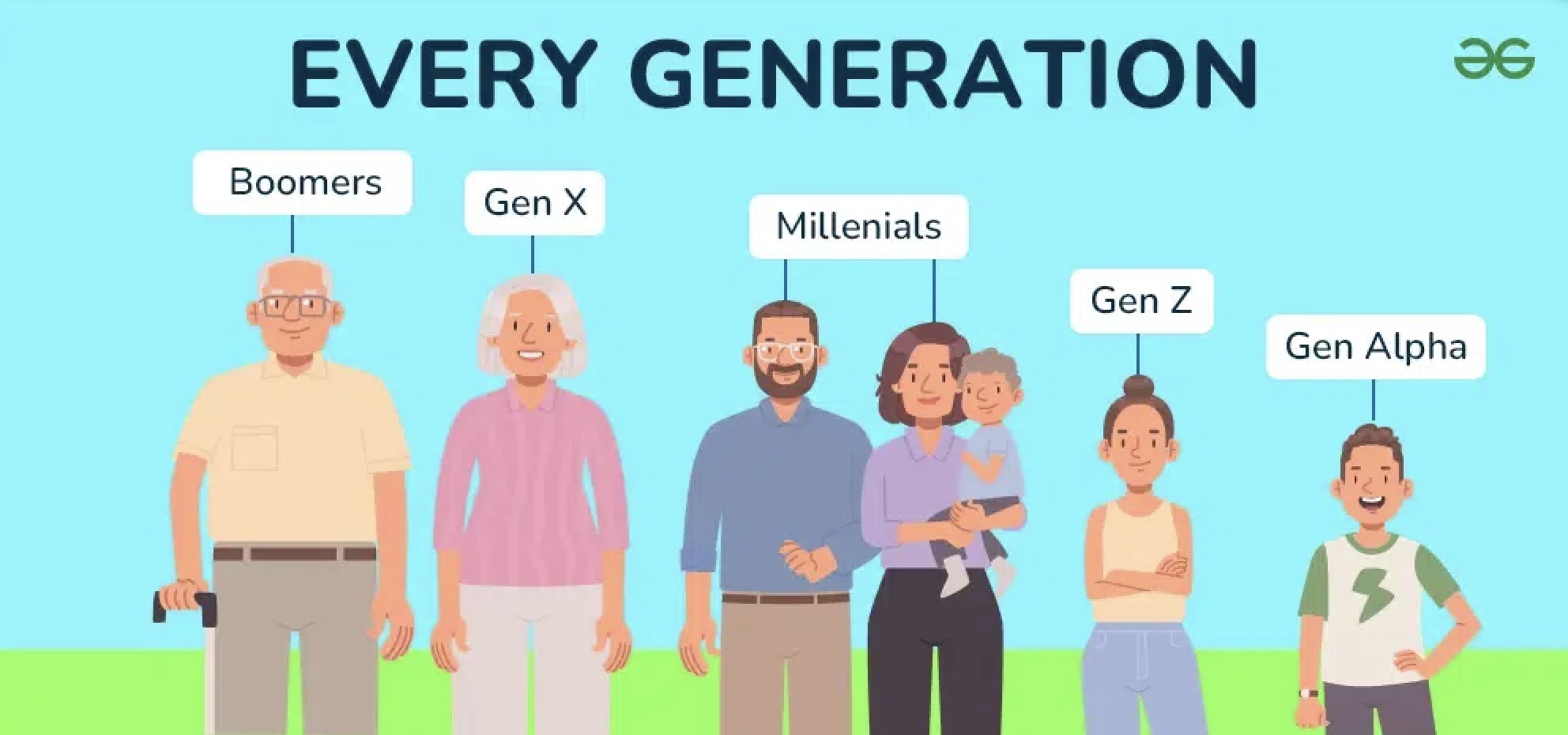Featured Image: Geeksforgeeks.org
Generational labels provide a fascinating lens to understand societal trends, collective experiences, and shifts in culture over time.
From the resilience of the Greatest Generation to the tech-savvy mindset of Generation Alpha, these generational distinctions offer a useful framework for analyzing behaviors, values, and historical milestones.
Whether you’re reflecting on your family history or trying to better understand your child’s world, this guide is your go-to resource for exploring generational dynamics.
The Greatest Generation (GI Generation)
Birth Years: 1901–1927
Key Characteristics:
The Greatest Generation, also referred to as the GI Generation, came of age during some of the most challenging periods in modern history. They lived through the Great Depression, fought in World War II, and rebuilt the world during post-war recovery. Their resilience, sense of duty, and collective spirit defined their era.
Major Historical Events:
- The Great Depression (1929–1939)
- World War II (1939–1945)
- The rise of industrialization and urbanization
Traits and Values:
- Known for their unwavering perseverance and work ethic
- Emphasized community, sacrifice, and patriotism
- Practiced frugality and resourcefulness
Cultural Impact:
Their experiences shaped the institutions we know today, from the global economy to social policies. Their leadership in rebuilding post-war societies laid the foundation for the Baby Boomer generation.
The Silent Generation
Birth Years: 1928–1945
Key Characteristics:
The Silent Generation grew up during times of economic hardship and conflict, including the Great Depression and World War II. As adults, they witnessed the post-war boom and embraced traditional family values. They were the bridge between the wartime struggles of their parents and the countercultural rebellion of their children.
Major Historical Events:
- World War II and its aftermath
- The Civil Rights Movement (1950s–1960s)
- The early Cold War era
Traits and Values:
- Strong adherence to rules and authority
- Prioritized stability and hard work over self-expression
- Known for being loyal and reliable
Cultural Impact:
Often referred to as “traditionalists,” they played a vital role in establishing the cultural norms of the mid-20th century, from the nuclear family ideal to the post-war economic boom.
Baby Boomers
Birth Years: 1946–1964
Key Characteristics:
Baby Boomers were born during the post-World War II population explosion. This generation experienced unprecedented prosperity and opportunities, fueling a wave of optimism and cultural transformation. Their youth was marked by the rise of the counterculture movement, while their adulthood saw them leading in economic growth and innovation.
Major Historical Events:
- Civil Rights Movement
- The Vietnam War and protests (1960s–1970s)
- The Moon Landing (1969)
Traits and Values:
- Valued personal achievement and ambition
- Known for their strong work ethic and pursuit of financial security
- Played a significant role in countercultural and feminist movements
Cultural Impact:
Baby Boomers shaped industries, politics, and culture as they pursued higher education, stable careers, and suburban lifestyles. Their influence continues to dominate conversations around retirement and healthcare.
Generation X
Birth Years: 1965–1980
Key Characteristics:
Generation X grew up during a time of significant cultural and technological shifts. Often described as the “middle child” between Baby Boomers and Millennials, they are known for their independence and adaptability. As the first generation to widely experience divorce and dual-income households, they developed a reputation for being resourceful and skeptical.
Major Historical Events:
- The end of the Cold War (1989)
- The rise of personal computers and the internet
- The AIDS epidemic (1980s–1990s)
Traits and Values:
- Independent and self-reliant
- Emphasized work-life balance and flexibility
- Often skeptical of authority and traditional institutions
Cultural Impact:
Generation X played a pivotal role in the tech revolution, driving the rise of Silicon Valley and the internet era. Their cultural contributions, from grunge music to indie films, redefined modern entertainment.
Millennials (Generation Y)
Birth Years: 1981–1996
Key Characteristics:
Millennials grew up during the internet explosion and the dawn of social media. Often described as the most diverse and educated generation, they value inclusivity, creativity, and work-life balance. They were shaped by economic recessions and student debt, leading them to redefine traditional career paths and life milestones.
Major Historical Events:
- September 11 attacks (2001)
- The Great Recession (2008)
- The rise of social media platforms
Traits and Values:
- Tech-savvy and innovative
- Value experiences over material possessions
- Emphasize diversity, equality, and environmental responsibility
Cultural Impact:
Millennials have influenced everything from workplace culture to digital marketing. Their focus on sustainability and mental health has also reshaped societal priorities.
Generation Z
Birth Years: 1997–2012
Key Characteristics:
As the first true “digital natives,” Generation Z has grown up immersed in technology and social media. They are socially conscious, value authenticity, and are highly entrepreneurial. Their adaptability and resilience set them apart, especially as they navigate a rapidly changing world.
Major Historical Events:
- The rise of smartphones and apps
- COVID-19 pandemic (2020)
- Global climate change activism
Traits and Values:
- Focused on authenticity and individuality
- Highly entrepreneurial and tech-dependent
- Advocates for social and environmental justice
Cultural Impact:
Generation Z is driving trends in digital innovation, activism, and new cultural norms. Their influence on social media platforms and global movements is reshaping industries and attitudes worldwide.
Here’s the continuation with the formatting maintained for the WordPress block editor:
Generation Alpha
Birth Years: 2013–2025
Key Characteristics:
The youngest generation, Generation Alpha, is growing up in a world dominated by technology, artificial intelligence, and social media. Predicted to be the most educated generation yet, they are expected to push the boundaries of innovation and redefine traditional education and work structures.
Major Historical Events:
- Climate change awareness and global action
- Post-pandemic societal shifts
- Rapid advancements in AI and automation
Traits and Values:
- Highly connected and digitally immersed
- Expected to prioritize education and creativity
- Likely to reshape cultural and economic systems
Cultural Impact:
Although still young, Generation Alpha is anticipated to redefine what it means to grow up in a hyper-connected world. Their experiences will likely influence future technological and societal advancements.
How Generational Names Are Defined
Generational names and boundaries are not set in stone; instead, they are shaped by social scientists, demographers, and cultural commentators who examine shared experiences and historical events that influence groups of people born within a specific time period. These labels are often used as a way to group individuals who are influenced by similar cultural, economic, and technological shifts.
The Origins of Generational Labels:
- Greatest Generation: Coined by journalist Tom Brokaw in his book The Greatest Generation (1998), this term honors those who lived through the Great Depression and World War II.
- Silent Generation: This term emerged due to the quieter, more traditionalist behavior of individuals during a time of economic recovery and conformity in the 1940s and 1950s.
- Baby Boomers: Named after the post-World War II baby boom, this generation’s label is directly tied to the sharp rise in birth rates between 1946 and 1964.
- Generation X: Author Douglas Coupland popularized the term in his 1991 novel Generation X: Tales for an Accelerated Culture, using it to describe the independent and skeptical nature of those born after the Baby Boomers.
- Millennials: The name was coined by William Strauss and Neil Howe in their book Generations: The History of America’s Future, 1584 to 2069. It reflects the generation coming of age during the new millennium.
- Generation Z: This name emerged as a natural progression after Millennials (Generation Y), often reflecting their place in the digital era.
- Generation Alpha: The label “Alpha” was proposed by social researcher Mark McCrindle, marking the beginning of a new alphabetic naming convention for generations.
Factors That Define Generational Boundaries:
- Historical Events: Major global or national events, such as wars, economic recessions, or technological advancements, often mark the start or end of a generation. For example, the September 11 attacks (2001) are considered a defining moment for Millennials.
- Cultural Shifts: Changes in values, norms, and behaviors, such as the rise of civil rights movements or the feminist revolution, help shape generational identity.
- Technology: Each generation is often associated with the technologies they grew up with. Baby Boomers had televisions, Generation X experienced the rise of personal computers, Millennials grew up with the internet, and Generation Z has never known a world without smartphones.
The Importance of Generational Labels:
While generational labels provide a useful framework for understanding broad trends, it’s important to remember that they are generalizations. Individuals within a generation can have vastly different experiences based on factors like geography, socioeconomic status, and cultural background.
Criticism of Generational Labels:
- Overgeneralization: Some critics argue that generational labels oversimplify complex human behaviors and experiences.
- Cultural Bias: Most generational research has been conducted in Western societies, which may not account for the diversity of experiences in other parts of the world.
- Arbitrary Boundaries: The exact start and end dates for generations can vary, leading to debates about who belongs to which cohort.
Despite these criticisms, generational labels remain a popular tool for analyzing societal trends and understanding how historical events shape different age groups.
Why Generational Understanding Matters for Parents
Understanding generational dynamics is especially relevant for parents raising children in today’s rapidly changing world. Each generation of children grows up in a unique cultural and technological environment, which directly influences their behaviors, values, and future opportunities.
Benefits of Generational Awareness:
- Parenting Strategies: By understanding generational trends, parents can adapt their parenting styles to better meet the needs of their children. For example, Generation Alpha is growing up in a fully digital world, so parents might prioritize digital literacy and screen time management.
- Bridging Generational Gaps: Recognizing the differences between generations helps parents build stronger connections with their children by appreciating their unique experiences and challenges.
- Shaping Future Generations: Parents who are aware of generational patterns can intentionally instill values and skills that prepare their children for the future, such as resilience, empathy, and adaptability.
Parenting Across Generations:
- Millennial Parents: As many Millennials are now raising Generation Alpha children, their focus on inclusivity, mental health, and work-life balance is shaping modern parenting norms.
- Generation X Parents: Known for their independence, Gen X parents often encourage self-reliance and critical thinking in their children.
- Baby Boomer Grandparents: Baby Boomers, as grandparents, often play a significant role in transmitting family traditions and offering support to younger generations.
Understanding how your child’s generation differs from your own can help you navigate parenting challenges with empathy and foresight.
Generational Crossovers and Ambiguity
Not everyone fits neatly into a single generational category. Individuals born on the cusp of two generations often share traits from both groups, creating unique perspectives and experiences.
Cusp Generations: Blending Traits:
- Xennials (1977–1983): A micro-generation between Generation X and Millennials, Xennials grew up with analog childhoods but adapted to digital adulthood.
- Zillennials (1993–1998): Straddling Millennials and Generation Z, Zillennials experienced the early days of social media while still remembering a time before smartphones.
Why Cusp Generations Matter:
Cusp generations highlight the fluidity of generational boundaries and remind us that individual experiences often transcend strict labels. This fluidity is important for parents who want to understand their children without relying solely on generational stereotypes.
Conclusion
Generational names and labels offer valuable insights into how societal trends, historical events, and technological advancements shape the behaviors and values of different age groups. While these labels are not absolute, they serve as a helpful framework for understanding broad patterns across time.
For parents, recognizing the unique characteristics of their child’s generation can provide valuable context for raising them in a world that looks very different from the one they grew up in. Whether you’re navigating digital challenges with Generation Alpha or teaching resilience to Generation Z, generational understanding is a powerful tool for fostering connection and preparing your child for the future.




